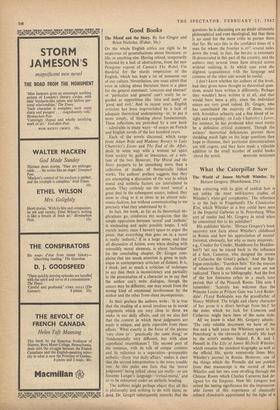What the Caterpillar Saw
`HER colouring with its glint of reddish hair is not unlike the most well-known studies of Whistler's white-girl symphonies.' The reference is to the lady in Fragonard's The Clandestine Kiss, which Whistler as a boy could have seen in the Imperial Galleries at St. Petersburg. What sort of reader had Mr. Gregory in mind when he committed this to his publisher?
His publisher blurbs : 'Horace Gregory's book uncovers new facts about Whistler's childhood in Russia and how his appreciation of mental' (oriental, obviously, but why so many misprints: e.g., Condor for Conder, Huddleson for Huddles- ton?) 'art can be traced back to the influence of a Scot, Cameron, who designed the rooms of Catherine the Great's palace.' And the Epi- logue concludes: 'Tsarskoe Selo.' Yet the sources of whatever facts are claimed as new are not indicated. There is no bibliography. And the first of the few footnotes refers to a much later period, that of the Peacock Room. This note I remember : 'Scarcely less welcome than the Princess Louise at Princes Gate was Lord Redes- dale'. ('Lord Redesdale was the grandfather of Nancy Mitford. The bright and chatty character of her prose is a direct heritage from his.)' So the notes which we lack for Cameron and Catherine might have been of the same style.
All we know is what Mr. Gregory admits: `The only reliable document we have of the five and a half years the Whistlers spent in St. Petersburg' is the chronicle of family life kept by the artist's mother. Indeed, E. R. and J. Pennell in The Life of James McNeill Whistler, which remains the standard biography as well as the official life, quote extensively from Mrs. Whistler's journal in Russia. However, one of the things which the Pennells did not publish from that manuscript is the record of Mrs. Whistler and her two sons strolling through the Chinese Room which Charles Cameron had de- signed for the Empress. Now Mr. Gregory has seized the lasting significance for the impression- able James of this experience of classically refined chinoiserie appreciated by the light of a
northern summer. The new 'interpretation of his life and art' tells us (p. 123) interestingly enough that a memory of Cameron's conception inspired the drawing-room at Lindsey Row. But, a little over-excited by his own perception, Mr. Gregory concludes (p. 246) that 'All roads in the best of Whistler's art lead back to the Chinese Room ' in the Catherine Palace on a summer's day.' Such inflation of an idea which would be per- fectly valid within bounds is as stultifying as it would be to project another interpretation of Whistler's career in terms of his preoccupation with the US Military Academy.
After Major Whistler had died in his service, the Tsar offered his widow places as pages for her sons. When the younger, James McNeill, was dismissed from West Point for his failure in chemistry, Jefferson Davis, the then Secretary of War, got him an appointment in the drawing division of the US Coast and Geodetic Survey. In the artist's career these remain the two offers of patronage, the one refused and the other ' accepted, which caused no tears, no disappoint- ment and no rumpus. It is in connection with a less graceful occasion, the row with Leyland, the shipowner who commissioned the Peacock Room, that Mr. Gregory advances his other sug- gestion for the origin of Whistler's inventions: 'Whistler's peacock themes were undoubtedly in- spired by Rossetti's peacocks.' This could well be so; although the possible significance for Whistler of the fight between Rossetti's peacock and gazelle. and its desolate, draggle-tail end- ing, is not discussed. That evidently was one of the Whistler anecdotes which, like the assault ),on the coloured Marquis de Marmelade, were considered too insignificant to include.
There is sad substance in what Mr. Gregory ' says, that 'the legend of Whistler's showmanship 'still tends to overshadow Whistler "the serious artist," who in his generation made enduring contributions towards an appreciation of Orien- tat art.' So surely a solitary paragraph on the drawings of Chinese ceramics made- for Murray 'Marks could have been illumined by reproduc- tion of just one of the beautifully drawn illus- trations to the 1898 Catalogue of Blue and White Nankin Porcelain forming the Collection of Sir 'Henry Thompson, a book . not easily within 'reach of the general reader?
Mr. Gregory continues of his subject : 'In retrospect and in relationship to contemporary painting, his work, however slight and tenuous it may seem, can be recognised as more Ameri- can and more "modern" than it seemed to be twenty years ago.' But Whistler will not come into his own again because of some fancied affinities with the works of Arthur B. Dove and John Marin. And to represent that battle- ' piece of a nocturne, The Falling Rocket, as a venture toward Jackson Pollock and non- figurative painting is as misleading as the claim made for some abstract expressionists that Monet was really one of them.
Mr. Gregory, of course and rightly, quotes Pound :
Here is part that's slight, and part gone wrong, And much of little moment, and some few
Perfect as Duren . . .
Whistler remains an inspiration to the 'artistic temperament. And he is collected again. ' The copper plates on which he worked are framed as Christmas presents for the rich. What is needed now is a really well-illustrated evalua- tion of his artistic achievement. The feeling that he is not quite considerable enough as an artist to stand as a subject.-without the back- ground noises of his period is pawky.
MICHAEL JA.114



































 Previous page
Previous page